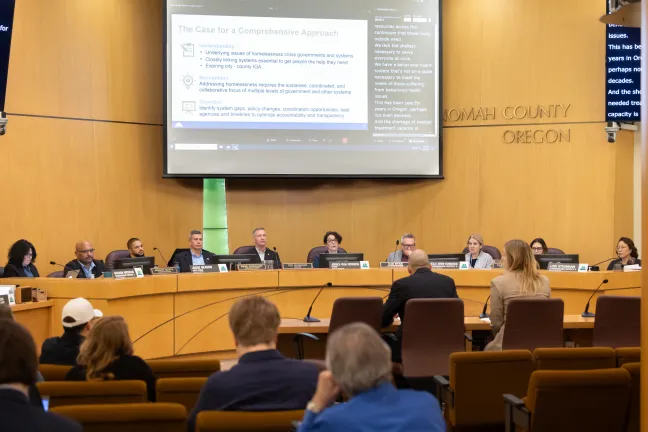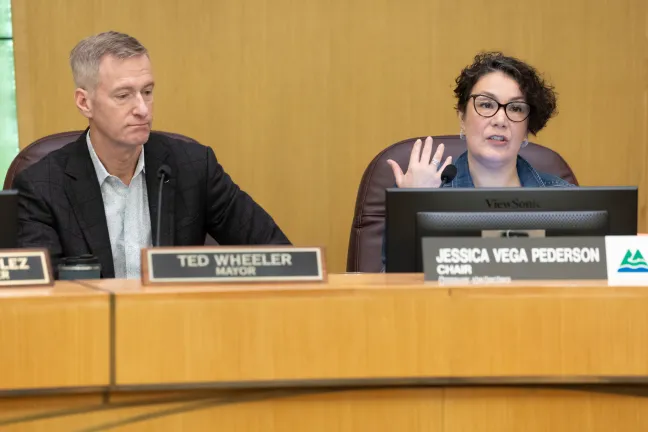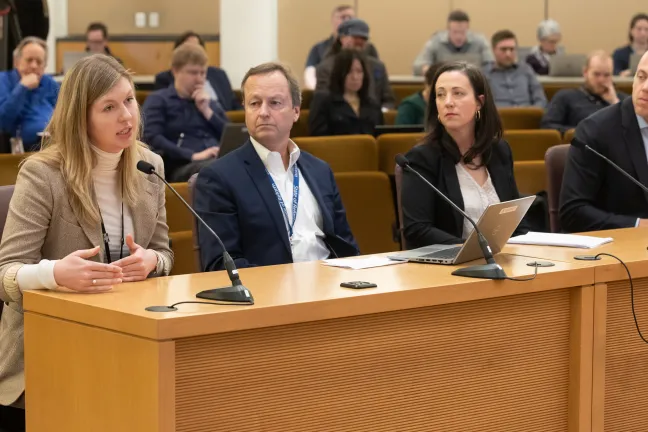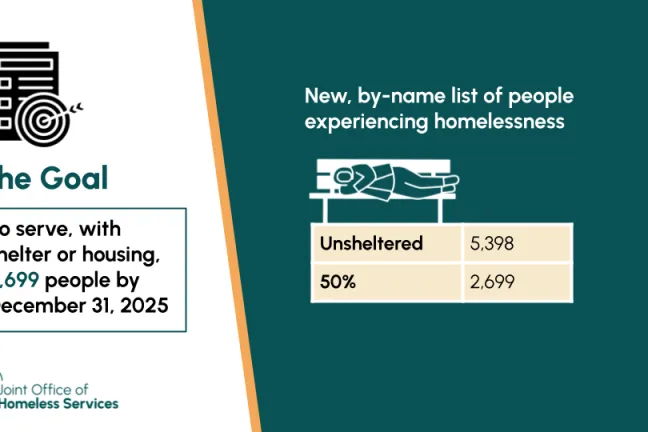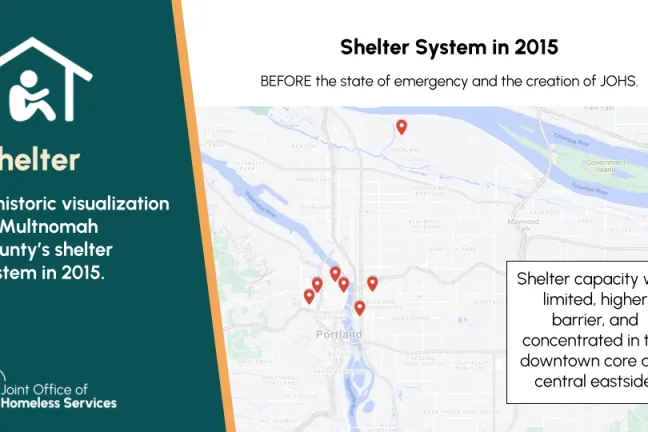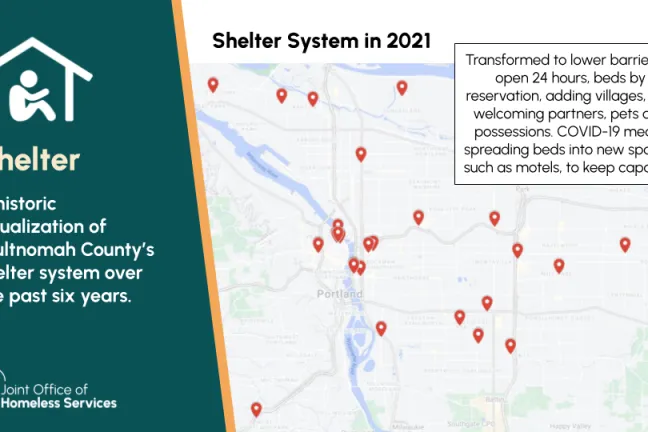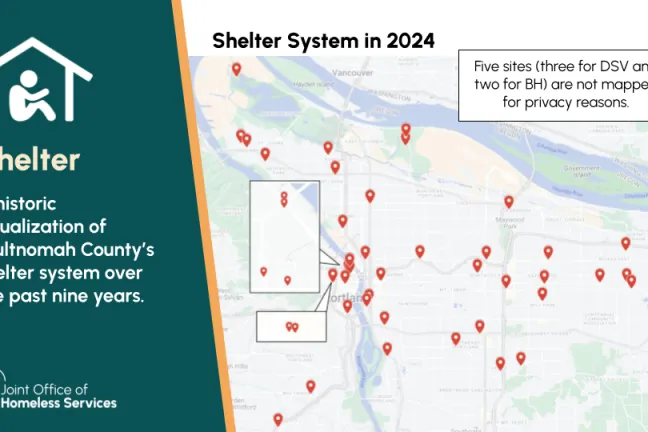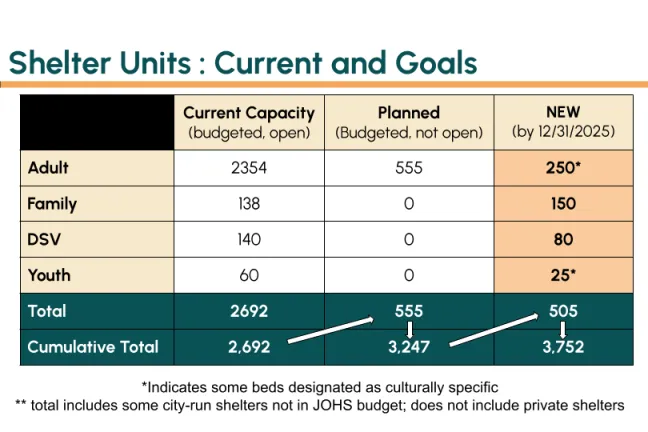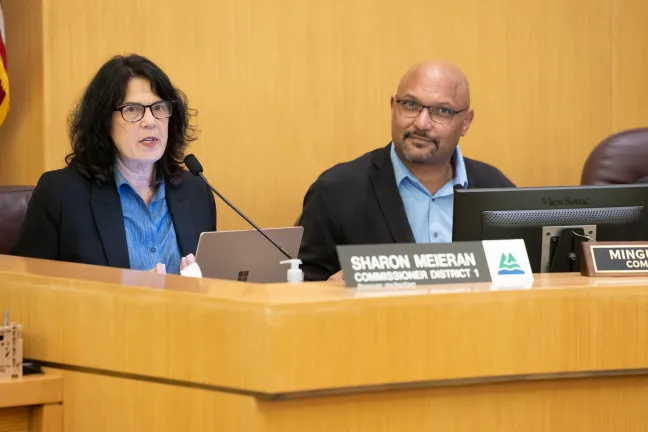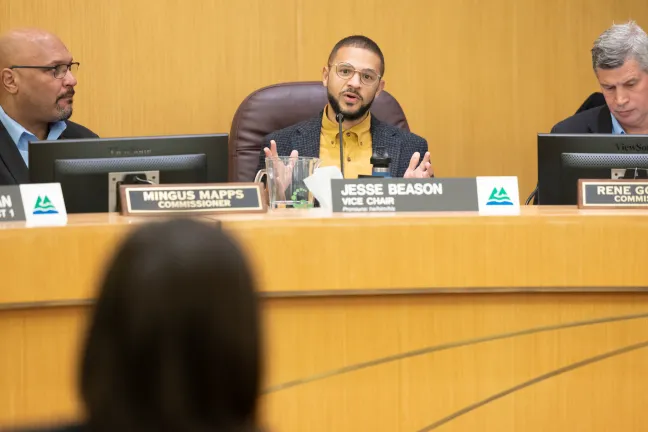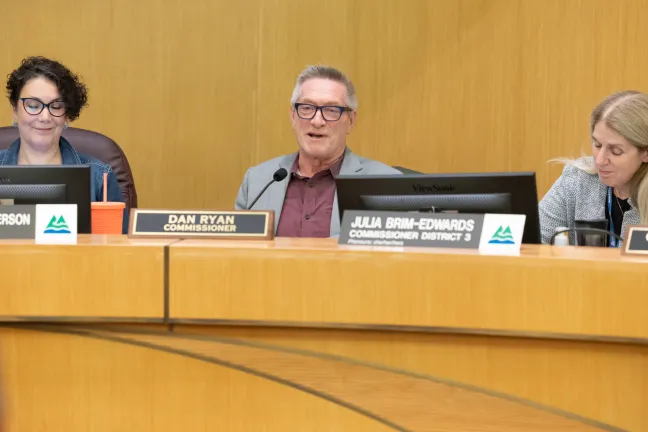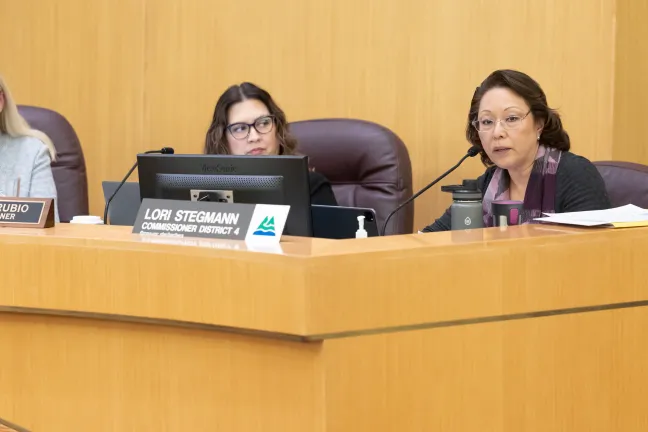Building on the unveiling of a strategic reset for the community’s response to homelessness, the Portland City Council and the Multnomah County Board of Commissioners met Tuesday, March 12, for a briefing on the Homelessness Response Action Plan and a newly developed community sheltering strategy key to achieving many of the plan’s initial goals.
The draft Homelessness Response Action Plan lays out goals, action items and timeframes for the community’s response to homelessness, with a focus on providing more people with safer options off our streets through an expanded range of partnerships that includes not only homeless services providers but first responders and healthcare and criminal justice organizations, too.
The plan emphasizes work to address racial disparities in homelessness. And it commits to providing clear and expanded access to the range of services someone needs to leave homelessness or never have to experience it in the first place.
“Our Homelessness Response Action Plan includes three things I know will help us deliver. One, bold goals and clear outcomes for the next several years. Two, a coordinated approach that makes homelessness the priority it must be across a complex system. Three, accountability and measurement of our current efforts — key metrics to assess the work, and better data-collecting and tracking,” said Chair Jessica Vega Pederson. “I want to be clear. We are not starting this work from scratch. We are expanding on what's come before and what's worked. We are letting go of what hasn't worked and we're moving forward.”
“We know we have a lot of work to do, and we’re coming together to fix it,” said Mayor Ted Wheeler. “The Homelessness Response Action Plan that we’re discussing today is a commitment to fundamentally transform our approach to homelessness in the City of Portland and to do it together. This is the first time a plan will provide a unified strategy that sets specific and achievable goals while covering critical areas previously neglected, including the important behavioral health component.”
Presenters walked through the framework of the plan, which assigns responsibility for work across jurisdictions and agencies to address homelessness in Multnomah County.
“This draft plan is our effort to get us all rolling in the same direction on a number of different fronts with lead agencies identified and timelines for completion,” said Chris Fick, newly appointed director of the Homelessness Response System, and previously Chair Vega Pederson’s chief of staff. “It recognizes the need to increase the availability of services across the continuum. And in doing so, it recognizes the responsibility to help those on our streets get into housing is far broader than the charge of the Joint Office alone.”
The plan includes nine goals and close to 100 action items. Each action item has an associated date and responsible parties expected to deliver.
“This is not just an end in and of itself, this is the beginning of hard work in the implementation process that will need to be done over the course of the next two years,” said Skyler Brocker-Knapp, senior policy advisor for Mayor Wheeler.
The nine overarching goals are:
- Systems development: Establish system-wide housing, navigation, care coordination and crisis intervention capability.
- Shelter expansion: Quickly increase shelter capacity, creating new beds but also using best practices and housing services so more people can move through shelter more quickly.
- Behavioral health: Increase access to appropriate levels of behavioral health supports and reduce barriers to access.
- Preventing homelessness: Establish rapid and long-term interventions aimed at preventing homelessness among at-risk populations.
- Strategic investments: Use the right dollars for the right service, including Medicaid funds and federal matching dollars.
- Affordable housing: Increase the production of affordable housing.
- Data and analytics: Improve data and analytics across the system to measure and communicate progress and challenges.
- Governance structure: Establish a structure that aligns strategies, resources and outcome measurements; clarifies roles and responsibilities; and includes nonprofit and private systems.
- Communications: Develop and launch a proactive communications strategy.
And some of the topline objectives highlighted by presenters include:
- Identify a baseline number of people experiencing unsheltered homelessness as of January 2024 (5,398, according to a new Joint Office of Homeless Services by-name list)
- Place 2,699 people — half of the baseline unsheltered number — in shelter or housing by the end of 2025.
- Increase exits from shelter to permanent housing by 15% by the end of 2025.
- Ensure 75% of people retain permanent supportive housing 24 months after they move in.
- End all behavioral health, health system and hospital discharges to the street by the end of 2025.
- End discharges from corrections to the street by 2026.
- End homelessness for youth aging out of foster care by 2027.
Community sheltering strategy
As part of the overall plan, presenters from the Joint Office of Homeless Services detailed a newly created Community Sheltering Strategy.
Dan Field, director of the Joint Office of Homeless Services, said the department dove into the work last fall, immediately after a joint City-County briefing from an independent consultant on improving the local homeless services system. Field said the sheltering strategy is an early demonstration that the other action items outlined in the Homelessness Response Action Plan will be achievable.
“We will have learnings and mistakes along the way, but I'm here to tell you that our experience gives me a lot of confidence. If we were able, in a number of months, to develop a shelter strategy that we're all agreeing to and all signing off on, and will now begin to lean in and execute — that fills me with a lot of confidence that the plan we saw this morning is achievable and doable,” Field said. “As we enter into implementation of the Homelessness Response Action Plan, we do it with the momentum and learnings that were provided with the shelter strategy work.”
Anna Plumb, the Joint Office’s deputy director, said the key objective for the sheltering strategy is achieving the Homelessness Response Action Plan’s goal of resolving unsheltered homelessness for 2,699 people, equivalent to 50% of the total number of people living outside or in vehicles as of January 2024 (5,398).
Staff from the Joint Office, the City of Portland and the City of Gresham developed the strategy, along with representatives from four service providers (Transition Projects, All Good Northwest, Path Home and NARA Northwest). A steering committee that included City Commissioners Carmen Rubio and Dan Ryan, and County Commissioners Lori Stegmann and Julia Brim-Edwards, met every two weeks to oversee the work.
Part of the work was establishing a baseline number of shelter beds. Plumb showed that shelter capacity has increased significantly since 2015. Back then, there were only a handful of shelters in Portland, focused on Portland’s downtown and central eastside.
“The capacity was clearly limited,” Plumb said. “And they were what we might consider higher-barrier than what we have now. Restrictions on couples staying together, for example, and not allowing pets in some of the facilities, things that we know now prevent folks from wanting to access shelter.”
As of 2021, the number of shelters had greatly expanded — including new locations and service models added during the COVID-19 pandemic — and shelters were lower-barrier and better able to meet the needs of the community.
“Many if not all of them are open 24 hours. Some of them have beds by reservation. We have villages. And now many of them are welcoming partners and pets. They have places for you to keep your stuff. So really becoming a place that folks are more likely to access,” she said.
And as of 2024, there are now 47 publicly funded or supported shelters across the system, including shelters for survivors of domestic violence and for people with behavioral health needs.
For beds funded by the Joint Office alone, shelter capacity has grown from 1,000 beds in 2017, to 3,220 budgeted for FY 2024 budget. “That is an over 200% increase, and it’s actually even a 95% increase from 2021, so significant additions to our system over the last several years,” Plumb said.
That total, however, includes beds budgeted but not yet open, and leaves out beds that are publicly funded but not by the Joint Office.
Plumb said the current capacity — beds open for people to use — of all publicly funded shelters in Multnomah County is 2,692 beds. In addition to that, 555 beds are currently budgeted by the City and County but are not yet open. Once those 555 additional beds are open, the capacity will be 3,247 beds.
The shelter strategy proposes adding an additional 505 beds on top of that, increasing the total to 3,752 beds by Dec. 31, 2025 — an increase over the current capacity by 1,010 beds and serving an estimated additional 1,850 people a year.
Plumb said creating these additional shelter beds alone won’t get the community to the goal of sheltering or housing an additional 2,700 people by the end of 2025. “It will be partnered with all the other systems and all the other services to serve that goal,” Plumb said.
In addition to outlining total how many more shelter beds are needed, the strategy recommends which types of shelter should be created (a mix of congregate, motel, City-led Temporary Alternative Shelter Sites and Safe Rest Villages, and alternative shelters), as well as strategies for serving priority populations, including LGBTQIA2S+ adults.
Other recommendations in the strategy include:
- Increasing exits from shelter to permanent housing
- Improving staffing ratios at shelters
- Increasing the availability of housing options for people at shelters (through programs like rapid rehousing)
- Ensuring that all sites have access to behavioral health supports
Brandi Tuck, executive director of Path Home, one of the organizations involved in developing the Community Sheltering Strategy, spoke to the importance of having housing interventions like rapid rehousing available through shelters.
Rapid rehousing “is an evidence-based practice with three components,” she said. “The first is to minimize the amount of time that someone experiences homelessness and move them quickly back into permanent housing. The second component is to provide rent assistance to people to help them stabilize in that housing. And the third component is to provide intensive, relationships-based case management to help people keep their housing for good.
Tuck said Path Home has seen extremely high rates of success with rapid rehousing programs. “The reason we have such success is because we fully implement this best evidence-based practice of providing long-term, relationships-based case management to help people keep their housing.“
Amy Thompson, director of housing services at NARA Northwest, another organization involved in the development of the sheltering strategy, said that incorporating behavioral health interventions into housing and homeless services is key. “The need for accessible treatment options designed to meet people where they're at with their various needs is critical,” Thompson said.
The sheltering strategy also acknowledges the need for increased resources across the county, including in East Multnomah County. Jessica Harper, Gresham’s director of livability services, spoke to the importance of that work. “Thanks to the investments from the County and Joint Office, we work six days a week to provide outreach and rapid rehousing to help people out of homelessness in Gresham. Our success is contingent on having access to shelter, especially having access to shelter beds that are located in our community,” Harper said. “It feels like the right step to be taking as a countywide group, and Gresham appreciates being included to be sure there is a strategy of implementation of additional shelter beds and rooms.”
Plumb emphasized that the sheltering strategy is one step toward reducing homelessness in Multnomah County, but must be part of a larger system as outlined in the Homelessness Response Action Plan. “I want to reiterate the focus of this work is to strategically add shelter that will serve as a pathway to housing while building community partnerships,” Plumb said. “Reducing houselessness is a whole community effort, and shelter needs to be integrated into that effort as a part of larger system.”
Elected officials respond to plan and shelter strategy
“I desperately wanted to like this plan,” said Commissioner Sharon Meieran. “I have been pressing for a lot of the concepts for years. I wanted to find something redeeming, but I think this tries to capitalize on the public's desperation, all of our desperation for collaboration and progress.”
“I appreciate the evolution of the city's thinking about our role within the Joint Office,” said City Commissioner Mingus Mapps. “It would be great as we move forward to more effective strategies to have some clarity about what the city's doing, what the county's doing and what our relationship is.”
County Commissioner Jesse Beason highlighted the rapid growth of shelters as highlighted in the presentation on the Community Sheltering Strategy. “The narrative we talk about shelters is not all the way informed on what we have accomplished,” he said. “Just recognizing that all those providers’ work has meant a lot over those last four or five years. I also want to recognize the geographic spread of the shelters and what a dramatic change that has been.”
The strategy’s emphasis on services in shelters will help “really shift shelters from the ‘cloak of invisibility,’ where we can pretend people are not suffering in our community, to really a necessary step on an ongoing path to solutions,” Commissioner Beason said. “I appreciate that we are building more and more services into shelter provision to ensure that, again, it is not just to ‘invisibilize’ the people we don't want to be reminded of that we failed.”
City Commissioner Rene Gonzalez said he appreciated the plan’s focus on ending discharges to the street. “You call out specifically the foster care system, and folks leaving the behavioral health and health systems. These are particularly cruel aspects of the status quo. The number of folks that end up unsheltered on our streets leaving foster care, leaving our medical care system, our behavioral health system,” Gonzalez said.
“For too long we have been fighting with each other over the diagnosis of the problem,” said City Commissioner Ryan. “It is difficult to get impact when you are siloed in your approaches. So today is different than what I have experienced in the past. There is a shared voice, a shared responsibility with goals, real-time data, and shared accountability.”
“I'm supportive of the direction we are moving in with the Homelessness Response Action Plan and also know it can be improved,” said County Commissioner Brim-Edwards. “I hope our structures are nimble enough that as we get data, as we explore strategies that either are new or ones that we've revamped or are trying to improve, that we continue to evaluate them and pressure-test them to see if they are actually creating the desired results on the ground.”
She also highlighted that the plan includes a 24-hour drop-off sobering center, a project which Commissioner Brim-Edwards has led. “I appreciate the City commissioners and City staff, as well as the County commissioners and County staff who have helped work on that. It is a key piece of the continuum of care,” she said.
“I cannot tell you how good it feels to see an aligned comprehensive approach to this work that incorporates government structure with accountability,” said City Commissioner Rubio. “Some of these models or approaches aren't necessarily new. What's different and what is new is there is committed leadership and new stakeholders and providers at the table. The painstaking work of intentionally braiding of resources behind this, the very fact of that, to me, is refreshing and needed.”
She also said it will be critical to identify new funding streams for affordable housing, as the Metro and City of Portland affordable housing bonds expire. “The critical question that we need to be asking ourselves is what is our next source of funding for affordable housing, and when will that come?” she said.
County Commissioner Stegmann said she was grateful the plan builds off previous work to increase services across the county, particularly in East County, which historically had very few homeless services options. “When we look at the shelter system now, it is much more geographically equitable,” she said.
"Are we where we need to be? Not yet. But this is a solid framework and foundation and the correct step in the right direction," she said. “I, for one, am incredibly proud of where we are today. I'm hopeful the strong progress we have made thus far stands as a foundational baseline in our collective partnership with each other and our community.”
Watch the full briefing and provide feedback
Watch the full briefing on YouTube here. Learn more about the Homelessness Response Action Plan and how you can provide feedback (before March 29, 2024) at this webpage.
